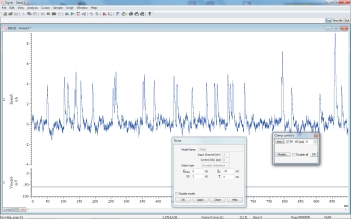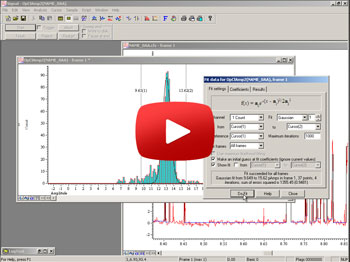Advanced features
Multiple sampling conditions
Signal includes a comprehensive multiple output states system that provides differing pulse outputs or stimuli while sampling. The order and repeats of each stimulus can be sequenced using a predefined protocol or executed randomly, semi-randomly or under manual control. Each frame of data is marked to indicate the stimulus that was used.
Dynamic clamping
High speed, fully integrated functions to simulate ion channels and leaks and use simulated synapses to generate hybrid networks. Optimised look-up tables and fast arithmetic are utilised in the Power1401-3 or mk II interface for maximum output data rates. Up to 15 selectable models can be used and switched between while sampling.

Exponential difference synapse model with superimposed
noise, triggered internally at randomised intervals
Voltage and current clamp
Interactively control holding potentials and pulse outputs using the graphical sequencer. Construct I/V plots, leak subtraction and curve fits on-line and off-line.
Single channel patch clamp
Detect single and multi-level channel openings on-line and off-line automatically. Produce measurements such as open/closed times and amplitudes and display result histograms. A special feature is the reverse convolution fitting of an amplifier's step response (SCAN analysis) to filtered single channel patch clamp data allowing superior time resolution of events.
Signal has a number of features for single channel patch clamp data analysis, including idealized trace formation using threshold detection, and generation of dwell time and amplitude histograms. This video tutorial demonstrates how to analyse single channel data using the threshold detection method.
Registered in England: 00972132
Registered office:
- Cambridge Electronic Design Limited,
- Technical Centre,
- 139 Cambridge Road,
- Milton,
- Cambridge CB24 6AZ
- ENGLAND.
VAT: GB 214 2617 96
Producer registration number: WEE/BD0050TZ
For our US customers, we can provide tax form W-8BEN, that identifies us as a UK company.
UEI : EQ4LMQ1M2ZS5
CAGE/NCAGE: KB797
NAICS: 423490
Hardware: 84716070
Software: 85235190
By email:
By post:
- Cambridge Electronic Design Limited,
- Technical Centre,
- 139 Cambridge Road,
- Milton,
- Cambridge CB24 6AZ
- ENGLAND.
By telephone:
(Int.+44) (0)1223 420186
From North America (Toll Free):
1 800 345 7794









